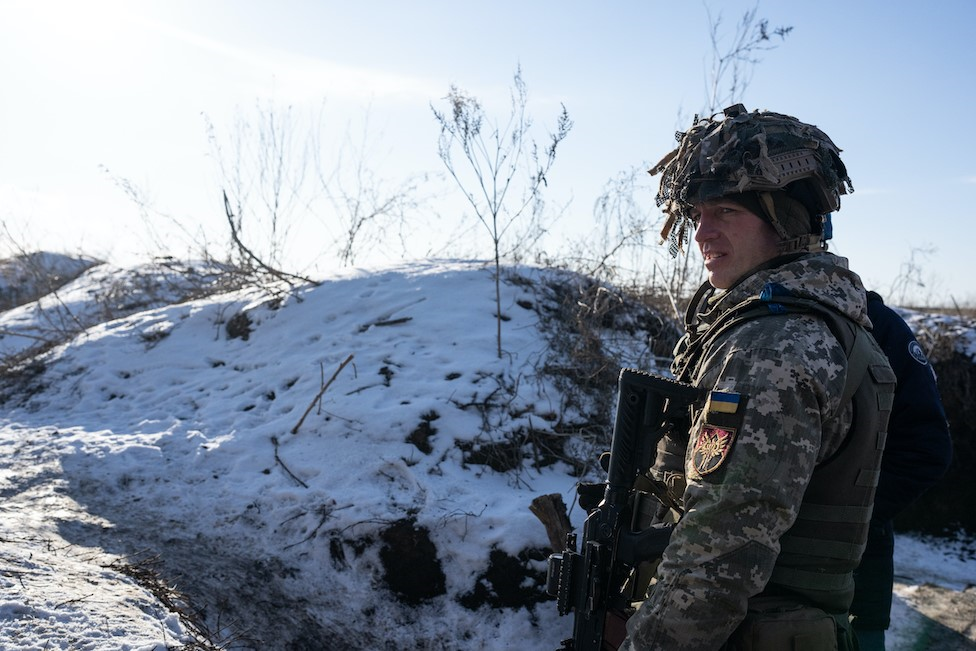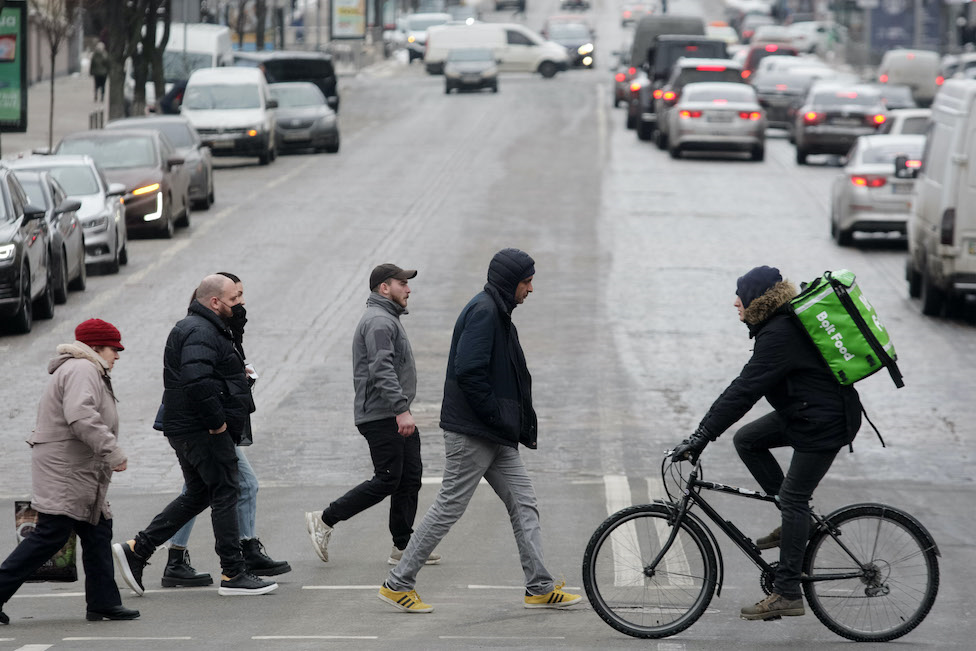Ukraine: How will we know if war has started?
- Published

Everyone is trying to second-guess President Vladimir Putin's intentions in Ukraine. The US is pulling embassy staff out as fears rise of looming conflict. But maybe it's already started, writes security and defence expert Jonathan Marcus.
The risk of an all-out war between Russia and Ukraine dominates the headlines.
All the obvious questions are being asked. Will Russia attack? Is President Vladimir Putin determined upon war come what may? Or can diplomacy secure peace?
But we cannot see inside President Putin's mind.
So here's another question - how will we know when hostilities commence?
Tanks rolling, rockets firing
The answer seems obvious.
Clearly massed Russian tank formations crossing Ukraine's frontiers, or a massive rocket barrage or air strikes against Ukrainian positions, would mark a dramatic escalation in the crisis and a shift to a new phase of the conflict.
The first alarms will come from the Ukrainian military itself, but Western satellites and intelligence-gathering aircraft may well spot the preparations for an imminent offensive.
There will probably be clear signs of an impending onslaught, says Michael Kofman, an expert on the Russian military at the US-based Center for Naval Analyses.
Among them are "the manning of formations", he says, since a lot of what has been deployed is heavy equipment rather than the troops themselves. Other signs could be "the dispersal of forces, an influx of logistical and support elements, and a shift in fixed-wing and rotary aviation".
Watch: Ros Atkins On... Ukraine tensions
But the question can also be answered in another way and for this we need to stand back and view the Russian campaign against Ukraine in its entirety.
We need to look at the full toolkit available to Moscow and assess how it is being used. And in this light, when you ask - how will we know if the conflict has started - then the answer may be that it already has.
Hostilities have actually been under way for some years.
Military pressure
Let's start from where we are.
Russia already occupies Crimea - part of Ukraine - and it provides practical assistance to anti-Kyiv rebels in the Donbas region.
Indeed it was the intervention of Russian armoured and mechanised units against Ukrainian forces in 2014 that prevented the pro-Russian rebels' defeat. Sporadic fighting has continued ever since. All sides supposedly support an international peace effort there, but little progress has been made.
Threat of force
Beyond this pressure there is also the threat to employ overwhelming military force.
The build-up of Russian combat formations around Ukraine's borders is extraordinary. This includes a significant deployment of forces to Belarus - which also shares a border with Ukraine - which might provide a closer jumping-off point for an assault towards the Ukrainian capital Kyiv itself.

This build-up is referred to by Russian spokesmen as an exercise and in no sense threatening. But its scale, the nature of the units deployed, and the gradual arrival of supplies and other "enablers" suggest that this is much more than routine manoeuvres.
Analysts have followed the build-up using civilian satellite photos. Numerous phone videos have been put online showing trains of equipment heading towards Ukraine or Belarus. And assessments of social media postings, correlated with the units seen to be on the move, provide a remarkable insight into what is going on.
Irrespective of what Moscow may say, Ukraine and its friends in the West have every reason to be worried.
Getting Moscow's story out there
The next tool available to Moscow is an attempt to influence the narrative.
On the one hand Russia says it is not preparing for war, though it very much looks as though it is. But, just as importantly, it has a story to tell - a narrative - where far from Ukraine being the victim, it is in fact Russia itself that is threatened.
This is the substance of the documents handed over to the US which seek to halt and in some ways reverse Nato expansion and create a new sphere of influence for Moscow.
While some aspects of Russia's concerns, like talks on strategic and other weapons systems, are widely seen as a good idea, on Nato enlargement it is unlikely to get any change - and it probably knows this.

Read more on Ukraine
EXPLAINED: Is Russia preparing to invade Ukraine?
FROM KYIV: Ukrainians wait as Russia faces off with the West
FROM BRUSSELS: Europe 'closest to war' in decades
UK SUPPORT: UK says it is sending weapons to defend Ukraine

But the narrative has another purpose too. It is the story that Russia tells to try to shape the way the whole Ukraine crisis is discussed, not just by Western governments or its own citizens, but by you and me, reading and writing this.
By all fair and rigorous independent analysis Russia is preparing for war with Ukraine, whatever its official spokesmen may say.
Subversion
There are other possibilities in the Russian toolbox too. Cyber-attack and subversion, for example. Ukraine certainly has been the subject of the former. Just over a week ago a number of government websites were hit though it was far from clear where the attack came from.
More recently the UK Government has claimed evidence that Moscow has selected individuals to form a new government in Kyiv - though whatever the suspicions, there has been no conclusive public evidence confirming Moscow's hand in such activities.
Michael Kofman says that a cyber element could be an important part of any Russian attack, because they can cripple critical infrastructure and disrupt Ukraine's ability to coordinate a military effort.
Blurred lines between war and peace
When Russia seized Crimea we heard a lot of talk about "hybrid" and "grey-zone warfare" and the alleged deniability of the operation, whose participants, though uniformed, wore no military insignia.
But there was no doubt who these troops were. And Crimea was seized with old-fashioned military force, rather than by some esoteric deception.
What is under way at present is the essence of "grey-zone warfare" - the blurring of the boundary between peace and war.

Life in Kyiv goes on
That's not how we tend to view things in the West.
But the Russian military has articulated a sophisticated doctrine that sees war and peace as a continuum where different tools are applied at different stages, sometimes in sequence, sometimes together, though with the same strategic aim.
And that ultimately is why the conflict has already been joined. The only question is how far along the "grey zone" continuum President Putin is willing to go.
Jonathan Marcus is a former BBC defence & diplomatic correspondent and an honorary professor at the Strategy and Security Institute at Exeter University